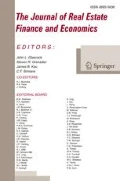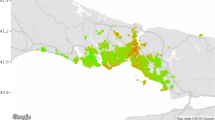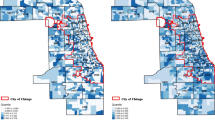Abstract
This paper investigates spatial dependence in the prices of office buildings in Hong Kong, London, Los Angeles, New York City, Paris, and Tokyo for 2007 to 2013. Compared to prior literature, we find low economic impact from spatial dependence in all six markets, and spatial and spatial-temporal dependence do not moderate the effects of hedonic characteristics statistically or economically. However, investor and seller types as well as neighborhood location have a significant impact on the economic and statistical significance of the spatial and spatial-temporal parameters. Spatial office price indices for London, Paris and Tokyo decline somewhat more than do hedonic indices during the crisis.



Similar content being viewed by others
Notes
See the Real Capital Analytics Ranking tool lists global property markets and players by transaction volume on a rolling 12 month window.
(Fisher et al. 1994) were the first to apply the hedonic framework to commercial real estate. Since that time, there have been approximately 20 studies that study commercial property markets through the hedonic framework. However, most of these studies look at realized rents or asking rents. Just under ten studies look at transaction prices in commercial property and a majority look at property price trends in the US.
Fisher et al. (1994) specify a hedonic model that measures the variation in price per square foot through property type, function, location, quality, local income, population, net income and capital expenditures of the owner.
Colwell et al. (1998) extended the hedonic model for Chicago office property by including more building characteristics, e.g., age, lot area, size and height, and more neighborhood characteristics, e.g. distances to airport, rail and road facilities as well as golf-courses to explain the variation in the log price per square foot.
There are other neighborhood and time components included in the study: metropolitan area dummies and property type dummies.
Tu et al. (2004) includes the floor area of the office unit, the age of the unit, the floor level where the office unit is located and whether the unit was leasehold to explain the variation in transaction prices. Nappi-Choulet and Maury (2009) document for Parisian sub-markets size, age and period of construction to explain variation in prices.
Chegut et al. (2014) broaden their controls to include transportation networks, investor types and per unit building quality characteristics to explain the price per square foot.
The hedonic literature is inconsistent in its usage of log price or price per square foot. However, given the heterogeneous size of buildings within our sample and the cross sample differences in building customs, we follow (Fisher et al. 1994) and (Fisher et al. 2007) who estimate models using price per square foot to control for cross-market building size heterogeneity. Moreover, size is correlated with other hedonic factors, e.g., age or stories, and without filtering for size reflects a size and hedonic attribute component.
(W ⊙ L) specifies the weight by using both the space and time of the nearest neighbor. It also ensures that each observation relates to its own nearest neighbor observation and not the neighbors of other buildings.
Data on Hong Kong’s office market reflects office condos as opposed to full building transactions.
Within the model we specify a g e and a g e 2 as these explain the depreciation component of the variation in transaction prices. Bokhari and Geltner (2014) document for US markets the impact of depreciation on commercial property values over the 2001 to 2013 period. The proportion of prices explained by depreciation varies across markets, but is economically significant across US markets.
The calculation for the average spatial dependence effect estimated by Eq. 3 is specified as follows: when calculated at the mean \(\rho [\sum _{i = 1}^{J=N}W_{ij}]logP_{j}\) this yields $1.39 for the London office market, ceteris paribus.
(Komatsu and Shimazu 2003) document high levels of depreciation for commercial property in Tokyo.
References
Anselin, L. (1988). Spatial econometrics: methods and models.Studies in Operational Regional Science. Dordrecht: Springer.
Bokhari, S., & Geltner, D. (2011). Loss aversion and anchoring in commercial real estate pricing: Empirical evidence and price index implications. Real Estate Economics, 39(4), 635–670.
Bokhari, S., & Geltner, D.M. (2014). Characteristics of depreciation in commercial and multi-family property: An investment perspective: Working Paper, MIT Center for Real Estate - Commercial Real Estate Data Laboratory.
se Can, A., & Megbolugbe, I. (1997). Spatial dependence and house price index construction. The Journal of Real Estate Finance and Economics, 14(1-2), 203–222.
Chegut, A.M., Eichholtz, P.M.A., Kok, N. (2014). Supply, demand and the value of green buildings. Urban Studies, 51(1), 22–43.
Colwell, P.F., Munneke, H.J., Trefzger, J.W. (1998). Chicago’s office market: Price indices, location and time. Real Estate Economics, 26(1), 83–106.
Devaney, S., & Diaz, R.M. (2011). Transaction based indices for the UK commercial real estate market: an exploration using IPD transaction data. Journal of Property Research, 28(4), 269–289.
Downs, D.H., & Slade, B.A. (1999). Characteristics of a full-disclosure, transaction-based index of commercial real estate. Journal of Real Estate Portfolio Management, 5(1), 95–104.
Eichholtz, P.M.A., Kok, N., Quigley, J.M. (2010). Doing well by doing good? green office buildings. American Economic Review, 100(5), 2492–2509.
Eichholtz, P.M.A., Kok, N., Quigley, J.M. (2013). The economics of green building. Review of Economics and Statistics, 95(1), 50–63.
Elhorst, J.P., Lacombe, D.J., Piras, G. (2012). On model specification and parameter space definitions in higher order spatial econometric models. Regional Science and Urban Economics, 42(1), 211–220.
Fisher, J.D., Geltner, D.M., Webb, R.B. (1994). Value indices of commercial real estate: A comparison of index construction methods. The Journal of Real Estate Finance and Economics, 9, 137–164.
Fisher, J.D., Geltner, D.M., Pollakowski, H.O. (2007). A quarterly transactions-based index of institutional real estate investment performance and movements in supply and demand. The Journal of Real Estate Finance and Economics, 34(1), 5–33.
Geltner, D.M., & Bokhari, S. (2008). A technical note on index methodology enhancement by two-stage regression estimation. Tech. rep.: MIT Center for Real Estate - Commercial Real Estate Data Laboratory.
Geltner, D.M., & Pollakowski, H.O. (2007). A set of indexes for trading commercial real estate based on the real capital analytics transaction prices database. Tech. rep.: MIT Center for Real Estate - Commercial Real Estate Data Laboratory.
Kelejian, H.H., & Prucha, I.R. (2010). Specification and estimation of spatial autoregressive models with autoregressive and heteroskedastic disturbances. Journal of Econometrics, 157(1), 53–67.
Kelejian, H.H., Prucha, I.R., Yuzefovich, Y. (2004) In Le Sage, J , Pace, R., Kelejian, H H, Prucha, I R, Yuzefovich, Y. (Eds.), Instrumental variable estimation of a spatial autorgressive model with autoregressive disturbances: Large and small sample results, (p. 18): Elseviers.
Komatsu, Y., & Shimazu, M. (2003). Life time estimation of office buildings based on general contractors construction records. Journal of Architecture. Planning & Environmental Engineering (565), 317–322.
LeSage, J.P., & Pace, R.K. (2009). Introduction to Spatial Econometrics.Taylor &. Boca Raton: Francis Group.
LeSage, J.P., & Pace, R.K. (2010). Spatial econometric models. In: In Handbook of Applied Spatial Analysis, (pp. 355–376). Berlin Heidelberg: Springer.
Nappi-Choulet, I., & Maury, T.P. (2009). A spatiotemporal autoregressive price index for the paris office property market. Real Estate Economics, 37(2), 305–340. doi:10.1111/j.1540-6229.2009.00244.x.
Pace, R.K., Barry, R., Clapp, J.M., Rodriquez, M. (1998). Spatiotemporal autoregressive models of neighborhood effects. The Journal of Real Estate Finance and Economics, 17(1), 15–33.
Pace, R.K., Barry, R., Gilley, W., Sirmans, C. (2000). A method for spatial-temporal forecasting with an application to real estate prices. International Journal of Forecasting, 16(2), 229–246.
Rosen, S. (1974). Hedonic prices and implicit markets: Product differentiation in pure competition. Journal of Political Economy, 82(1), 34–55.
Tu, Y., Yu, S.M., Sun, H. (2004). Transaction-based office price indexes: A spatiotemporal modeling approach. Real Estate Economics, 32(2), 297–328. doi:10.1111/j.1080-8620.2004.00093.x.
Acknowledgments
For research assistance we thank Ruud Weerts. For guidance and constructive comments we thank the participants at the MNM conference as well as our insightful discussant Albert Saiz. Moreover, we are grateful for the comments from the anonymous referee whose comments enhanced our manuscript. We are grateful to Real Capital Analytics for providing data for this research. All errors or omissions remain that of the authors.
Author information
Authors and Affiliations
Corresponding author
Appendices
Appendix A: Location Dummies and CBD
The market and sub-market breakdown for the six office markets is constructed as follows. For London, the first two to three letter pre-fix of their postal codes is used to delineate sub-markets, e.g., EC to represent London City. We estimate relative to the South bank. The CBD is denoted as Westminster and London City.
For Paris, the markets have been divided into the Parisian arrondissements and greater suburbs, where the CBD is transactions occurring in the Quartier Central des Affaires (8th Arrondissement), and La Defense (15th Arrondissement). The 1st, 8th, and 15th Arrondissements are used as the base case.
In Tokyo, the city is broken down into administrative wards. The CBD is designated as the combination of the Chiyoda, Chuo, Minato and Central Wards. The wards included in the CBD as well as the Shinjuku Ward are used as the base case.
For Hong Kong, the Admiralty and Central districts form the CBD. These districts as well as the West district are used as the base for relative location value estimates.
New York City’s metro area is broken down into boroughs and then further disaggregated on Manhattan into Downtown, Midtown and Uptown. Downtown and Midtown Manhattan are used as the CBD for the New York City Metro area.
Finally, Los Angeles is defined by its zip-codes with ”Old Downtown” and ”New Downtown”, e.g., zip codes 90017 and 90071 as the locations for the CBD. These zip-codes plus 90210 are designated as the base case.
Appendix B: Spatial Estimation Procedure
Estimation of the spatial models is carried out by using the efficient version of the Generalized Method of Moments estimator developed in (Kelejian and Prucha 2010). We refer the reader to (Kelejian and Prucha 2010) for details on the estimation procedure. In a first step, we use a two stage least squares (2SLS) approach to estimate the model parameters. Since the spatial and temporal components contain the log price per square foot as an argument they are endogenous regressors. To find suitable instruments for the spatial and temporal components we follow the discussion given in (Kelejian and Prucha 2010), where for the SARAR model we note that the expected value of the endogenous regressors, i.e., the spatial and temporal dependence regressors, is a function of the exogenous components as shown in the following equation:
Equation (6) shows that we can use the linearly independent columns (X, W X, W 2 X, T) as instruments, and (Kelejian et al. 2004) has shown that a limit of two polynomial expansions are sufficient. To avoid over-identification issues we also restrict the columns of the hedonic matrix used in the multiplication with the power series of the spatial weights to the log size and age. For the STARAR model, we use the same idea and use the first two elements of the power series of L and (W ⊙ L) when determining the instruments. Collecting the regressor variables (WlogP, X, T) into the matrix Z and the instruments into the matrix H and use a 2SLS estimator given by:
where in the first step, with vector \(\widetilde {\theta }\) collecting the model parameters ρ, β, and δ, and \(\hat {Z} = H(H^{\prime }H)^{-1}H^{\prime }Z\). In the second step, the errors estimated using the first step 2SLS estimate are used to construct a nonlinear moments estimator for the spatial error parameter. The non-linear estimator for the spatial error parameter λ is found by minimizing the following criterion function:
where γ and Γ are a 2 × 1 vector and a 2 × 2 matrix, respectively. The vector α contains λ and λ 2 as elements. The elements of γ and Γ are given by:
and Ψ denotes the inverse of the covariance matrix of the two moment conditions which depends on the spatial error parameter λ. We use a first inefficient estimator for λ where we set the matrix Ψ equal to the identity matrix. A second efficient estimator for λ is found by using the matrix Ψ in the function given in Eq. 8. To determine the elements of Ψ we define the following:
where the index r = 1, 2, \(A_{1} = W^{\prime }W - diag(w_{i}^{\prime }w_{i})\) and A 2 = W. Given these relations we have an estimator for the matrix Ψ given by:
with r, s = 1, 2. A second efficient estimator for λ is found by minimizing the function given in Eq. 8 using Ψ as weighting matrix. The standard deviation of the efficient estimator of the spatial error parameter is given by:
where \(J = \Gamma \left [ \begin {array}{ll} 1 \\ 2 \lambda \\ \end {array} \right ]\). In the third step, we use the estimated spatial error parameter to perform a Cochrane-Orcutt type transformation, i.e., we use \(\widetilde {\log {P}} = \log {P} - \lambda W \log {P}\) and \(\widetilde {Z} = Z - \lambda W Z\) instead of logP and Z in the 2SLS procedure given in Eq. 7.
Rights and permissions
About this article
Cite this article
Chegut, A.M., Eichholtz, P.M.A. & Rodrigues, P.J.M. Spatial Dependence in International Office Markets. J Real Estate Finan Econ 51, 317–350 (2015). https://doi.org/10.1007/s11146-014-9484-x
Published:
Issue Date:
DOI: https://doi.org/10.1007/s11146-014-9484-x




